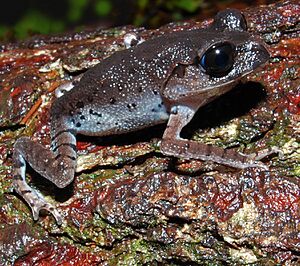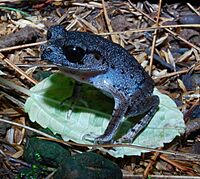Hasselt's toad facts for kids
Quick facts for kids Hasselt's toad |
|
|---|---|
 |
|
| Male Leptobrachium hasseltii from Bogor, Java | |
| Conservation status | |
| Scientific classification | |
| Genus: |
Leptobrachium
|
| Species: |
hasseltii
|
| Synonyms | |
|
Megophrys hasseltii (Tschudi, 1838) |
|
The Hasselt's toad (scientific name: Leptobrachium hasseltii) is a special kind of toad or frog. It is also known as the Java spadefoot toad or Hasselt's litter frog. You can find this frog in parts of Southeast Asia.
This frog was named after a Dutch scientist called Johan Conrad van Hasselt. Today, we know for sure that this species lives on the islands of Java, Madura, Bali, and the Kangean Islands in Indonesia. While some reports say it lives in the Philippines, scientists now think those frogs might be a different, unnamed species.
The Hasselt's toad is very important because it is the main example (or type species) for its group, the Leptobrachium genus. Because of this, many frogs from different areas were first thought to be Hasselt's toads. Later, scientists realized they were actually new, separate species. For example, frogs from Hainan (China) are now called Leptobrachium hainanense. Frogs from mainland China are Leptobrachium liui, and those from Thailand and Myanmar are Leptobrachium smithi.
About Hasselt's Toad
The Hasselt's toad has a large head that is wider than its body. It has big eyes with a bright red (scarlet) color. Its toes are round at the tips and have small webs at the bottom. Its skin feels smooth.
Adult Hasselt's toads are dark on top, with darker circle patterns. Their belly is white with black spots. Young frogs (juveniles) are bluish. Female toads are a bit bigger than males. Females can grow up to 70 millimeters (about 2.7 inches) long from their snout to their bottom. Males are usually around 60 millimeters (about 2.3 inches) long.
Where They Live
Hasselt's toads live on the ground in forests. They prefer both mountain (montane) and lowland rainforests. They hide among the leaves and other plant material on the forest floor.
The young frogs, called tadpoles, live in calm pools and ponds. Sadly, these frogs are at risk because their forest homes are being cut down. This is called deforestation.




